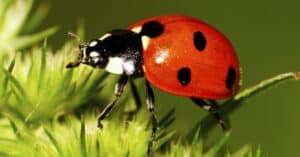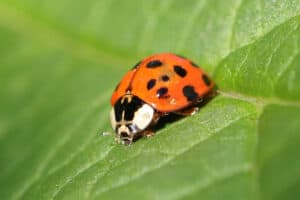New Hampshire is a state located in the New England region of the Northeastern United States. It shares a border with three U.S. states and one Canadian province: Vermont to the west, Maine to the east, Massachusetts to the south, and Quebec to the north. The state’s capital city is Concord, while Manchester holds the title of the largest city. As the ninth state to be admitted to the Union, New Hampshire is known for its storied past and the role it played in the American Revolutionary War. Geographically, the state contains forests, mountains, ocean coastline, and abundant granite formations.
New Hampshire State Insect

The ladybug is the official New Hampshire state insect.
©Oakland Images/Shutterstock.com
The New Hampshire state insect is commonly known as the ladybug, ladybird, or lady beetle (Coccinella septempunctata). This lovely beetle was designated as New Hampshire’s official state insect in 1977 thanks to the Broken Ground School in Concord, whose students sponsored the idea. The ladybug is the official state insect of five other states, including New York, North Dakota, Ohio, Massachusetts, and Tennessee. It is also the official state “bug” of Delaware.
Ladybugs are small beetles commonly identified by their red backs covered with black spots. Although not all lady beetles are red with black spots, most are brightly colored as a warning to potential predators. They range from 0.08 to 0.4 inches in length, depending on the species. Ladybugs have six legs and two pairs of wings, which flap about 85 times per second while in flight.
One interesting fact about ladybugs is their widely popular use as beneficial insects for commercial and home purposes. When introduced to a farm or garden, they help maintain plant health by controlling pests, especially aphids. Ladybugs will eat up to 50 to 60 aphids per day, as well as other insects and larvae that are often harmful to plants.
It’s no wonder New Hampshire chose this beautiful and helpful species as the official state insect!
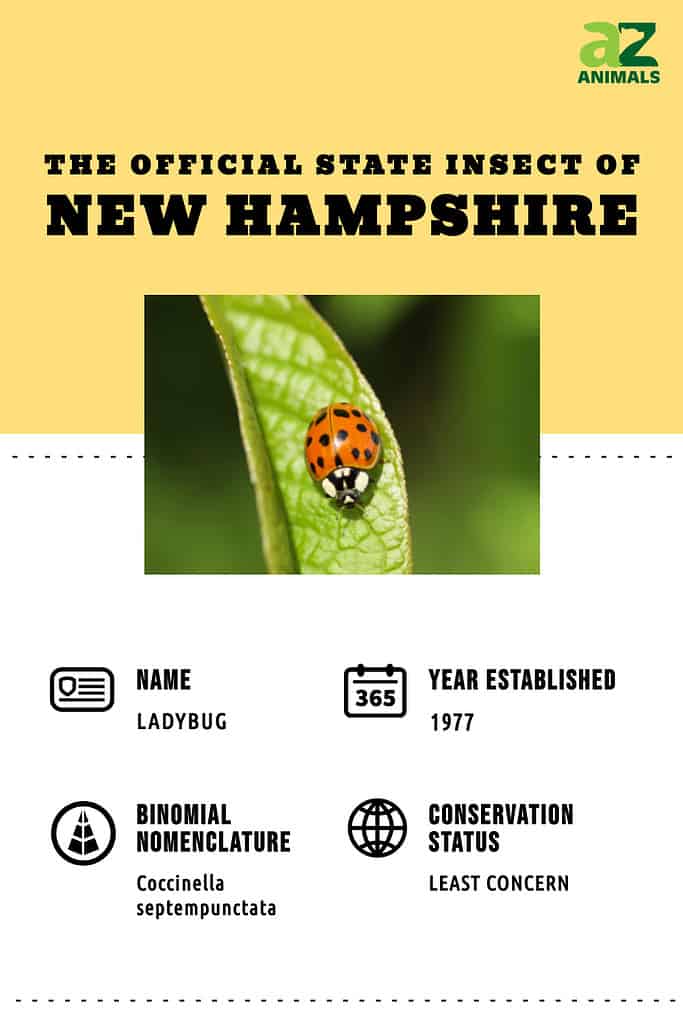
Range and Habitat

Ladybugs are found all across the world in various climates.
©Vojce/Shutterstock.com
New Hampshire’s state insect can be found on every continent in the world except Antarctica. Their primary habitats include forests, meadows, agricultural fields, and urban gardens. Although ladybugs typically prefer sunlit areas with plenty of foliage, some species are able to adapt to more extreme environments such as high-altitude mountains and arid deserts.
These resilient beetles face various threats to their survival, including competition from their own kind! Certain lady beetle species such as Harmonia axyridis have become increasingly widespread across the globe. This particular invasive species threatens other ladybugs by out-competing them for food and eating the native species’ eggs. All around the world, ladybugs also face threats from habitat destruction, climate change, and urbanization.
Despite these threats, ladybugs have been around for millions of years and are not currently classified as endangered in the United States.
Life Cycle
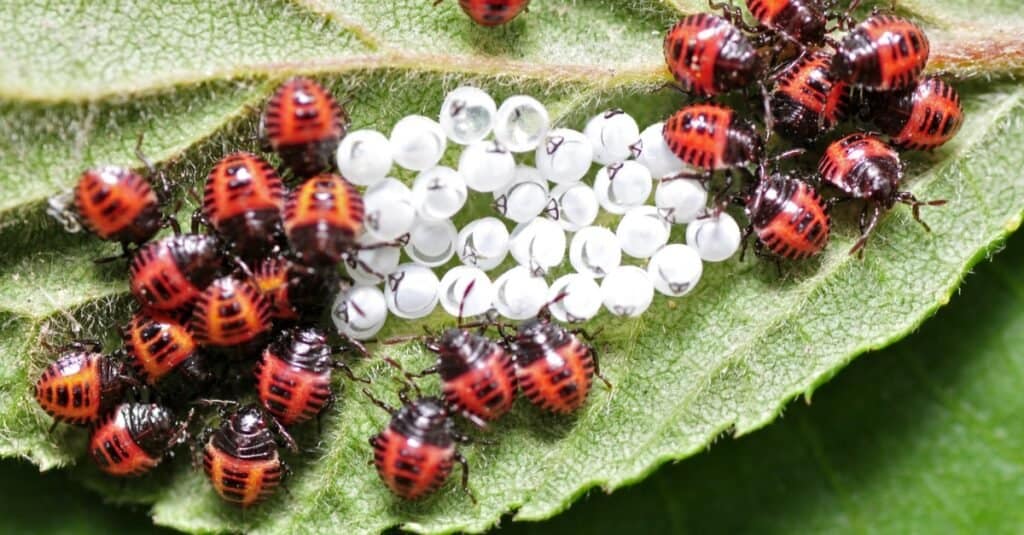
Ladybug larvae typically consume the unhatched eggs in their clutch after hatching.
©QiuJu Song/Shutterstock.com
From tiny egg to full-grown adult, the entire life cycle of a ladybug only takes about four weeks. Typically, female ladybugs will lay their eggs in places where the larvae will have a sufficient supply of food available once they hatch, such as an aphid colony. Some females can even lay up to 1,000 eggs in one season. Depending upon the species and climate, the newly laid eggs will hatch in about four to eight days. Once hatched, the young larvae will feed and pass through several development stages before transforming into pupae. The resulting pupal stage lasts roughly seven to 10 days, and the adult ladybugs emerge once it is complete. The lifespan of an adult ladybug usually ranges from a few months up to a year.
Climate plays a large role in the life cycle of a ladybug. In temperate climates, ladybugs usually breed from the late spring months into the early summer. However, warmer regions may see their mating seasons extend year-round. In temperate areas, ladybugs are able to hibernate through the winter. During hibernation, adults gather in clumps of various sizes and spend the winter months underneath rocks or dead vegetation.
Defense
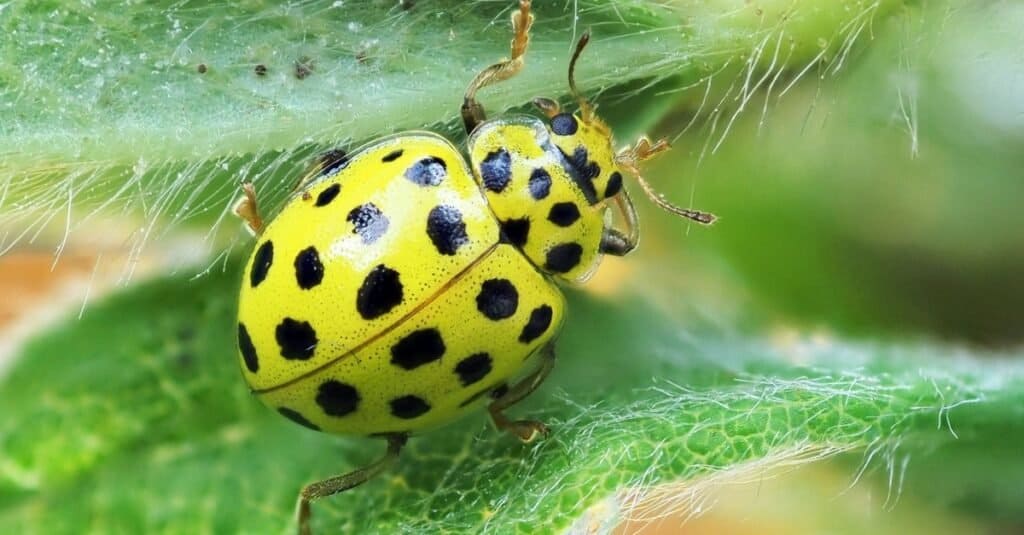
Ladybugs are not always red, but most are brightly colored as a defense mechanism.
©L-N/Shutterstock.com
Many species of ladybugs have bright warning coloration to deter potential predators such as birds and larger insects. In the eyes of a predator, the bright colors of ladybugs are an indicator of their toxicity and foul taste. If a predator ignores the warning provided by the coloration, ladybugs are prepared with a second line of defense. When disturbed, the small beetles are able to perform a defensive act known as “reflex bleeding“. By excreting small droplets from their joints, they give hungry predators a sample of their poisonous, bitter bodily fluid. This defense is quite effective and is especially important during the pupal stage, during which ladybugs are virtually immobile.
Pest Control for Farms and Gardens
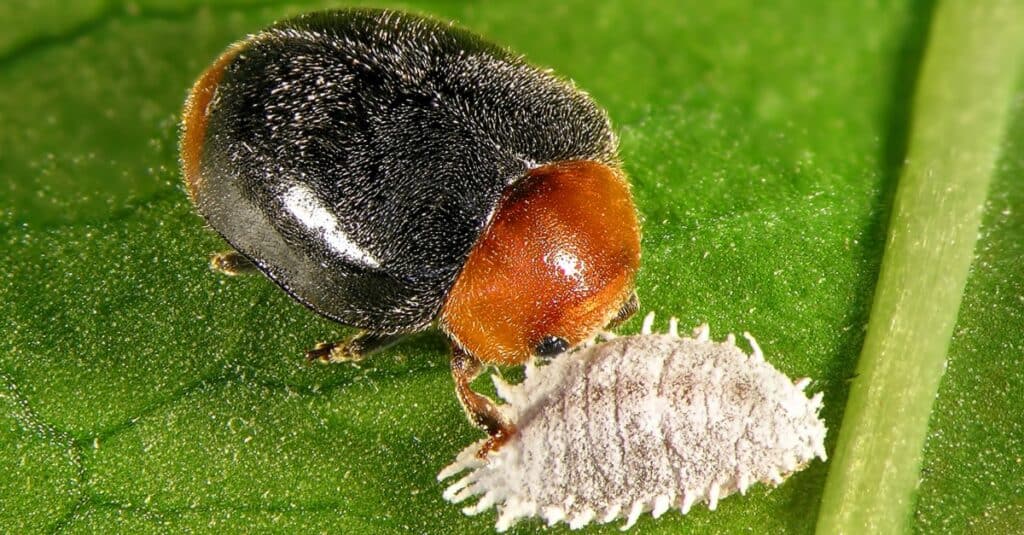
Ladybugs eat various agricultural pests such as aphids, spider mites, and mealybugs, pictured.
©Protasov AN/Shutterstock.com
Ladybugs have long been valued as beneficial insects for commercial and home use. In fact, their role as pest control specialists was noted as early as 1814 in England. When introduced to a farm or garden, they can significantly mitigate the populations of aphids and other plant-harming insects. Their short reproduction cycle and substantial appetite make them a great natural alternative to pesticides and other environmentally harmful pest control options.
The next time you see beautiful ladybugs in your garden, make sure to thank them for keeping it pest-free!
The photo featured at the top of this post is © Oakland Images/Shutterstock.com
Thank you for reading! Have some feedback for us? Contact the AZ Animals editorial team.




